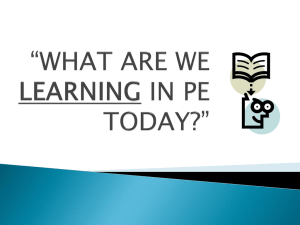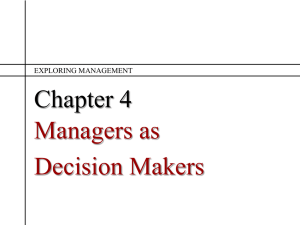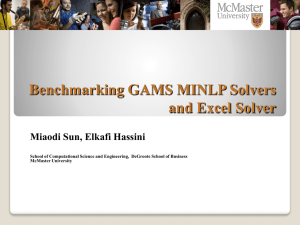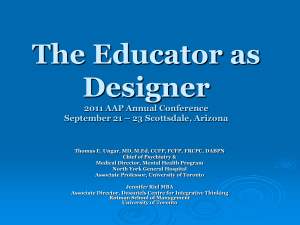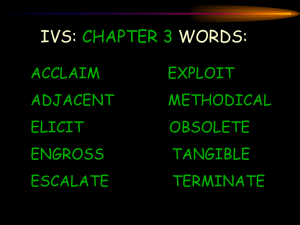This paper is really about problem solving - Oracle
advertisement
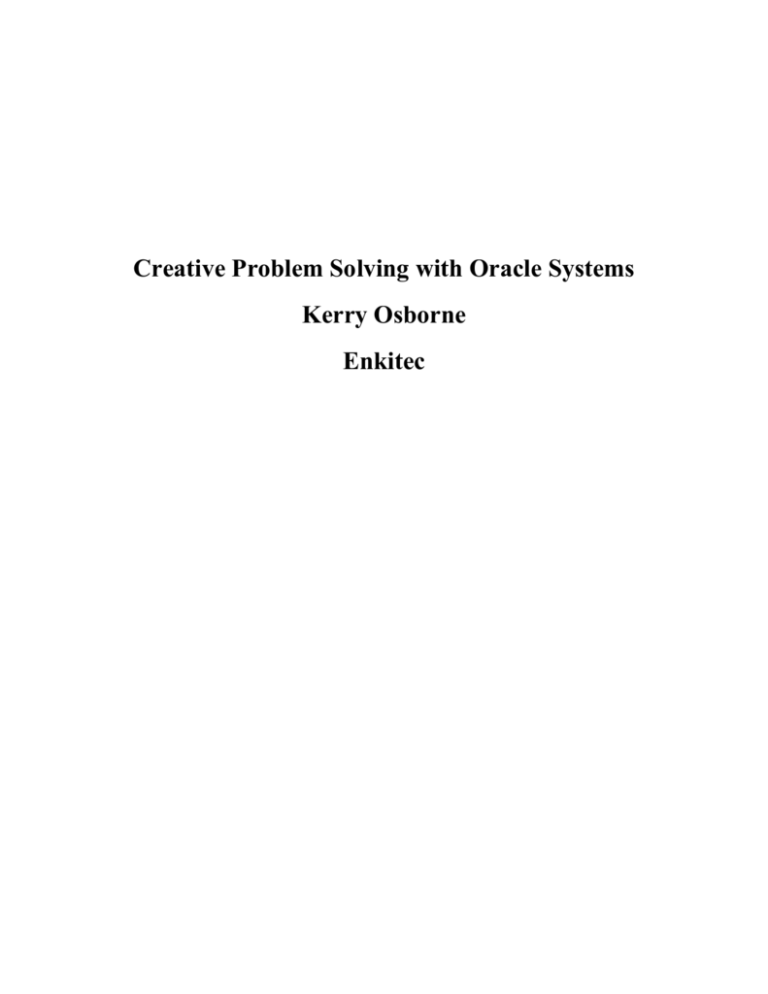
Creative Problem Solving with Oracle Systems Kerry Osborne Enkitec Introduction This paper is really about problem solving. It’s about how we think about problems and how we resolve those problems. Specifically it is about how we solve problems involving computer systems. Over the years, I’ve been privileged to work with people that were incredibly good at solving problems and I’ve also worked with people that weren’t. But it’s been very difficult to tell which is which without watching them actually do what they do. I’ve worked closely with hundreds of extremely bright people. However, there seems to be little correlation between raw intelligence and the ability to quickly solve difficult problems. I’ve worked with lots of dedicated, hard working people as well. But this characteristic also does not foretell success. Neither does having a stellar technical background with loads of experience. So why is it that some people seem to be gifted with seemingly super-natural problem solving skills even though their IQ’s, work ethic and backgrounds are similar to other less successful problem solvers? That’s a question I’ve been trying to answer for many years. While I don’t have all of the answers, I do have some ideas and some insights that I hope will be helpful. A word of warning: I am not a psychologist. I have not spent my career in pursuit of scientific proof of my opinions. Rather, I have spent my career solving computer problems and working with relatively large numbers people that do the same. So the opinions expressed in this paper are based solely on my observations and reflect my attempts to make sense of what I have observed. Two Approaches There seem to be two basic approaches to solving the problems we commonly encounter with computer systems. For the purposes of this paper I will call one approach intuitive and the other methodical. Most of these problems are complicated and they often have multiple solutions which vary in their effectiveness, time to implement and cost. There are usually many factors in play and numerous possibilities for resolving the issue(s). In short, these are very difficult problems with multiple possible solutions. The objective is almost always to minimize financial impact to the business. That is, the problem is perceived to have a substantial cost to the business, whether it has actually been calculated or not. So the outcome is usually driven by economics and quite often comes down to attempting to solve the problem in the least amount of time. The problem solving activity can generally be broken into a few distinct steps: 1. 2. 3. 4. 5. 6. Defining the problem Gathering data Postulating a reason for the problem Listing possible solutions Ordering the possible solutions Attempting the solutions in the defined order until one is deemed a success A brief discussion of each step follows: Defining the problem Oddly enough, this step is actually one of the hardest to get right. It’s can be very difficult to get computer people to think about the business value of a solution to a problem. By nature we are much more likely to define a problem as “reduce the number of full table scans” than we are to define it as “make Sally’s report run faster”. Unfortunately (for us), the business doesn’t care how many full table scans we have and therefore shouldn’t pay us to eliminate them just for the sake of eliminating them. Also keep in mind that how the problem is defined can imply a certain solution. Gathering Data Gather as much data as necessary, both factual and antidotal. The problem with this step is that everyone has an opinion. These opinions may be factual or not. So the challenge for the professional problem solver is to separate the opinions from the facts. The best problem solvers listen to every opinion expressed but store them away for future analysis after collecting hard evidence that either substantiates the stories or not. It’s a little like the CSI show on TV. The crime investigators are constantly questioning suspects and witnesses, but in the end they have to rely on the hard evidence. They use the line “The evidence tells me …” about three times an episode. So listen closely, but don’t take everything you hear as gospel. Postulating a reason (or reasons) for the problem – This step has several parts. The evidence must be evaluated, a theory must be devised, and the theory should be tested if possible. This can be an iterative process if the testing disproves the original theory. There is a real tendency to leap directly to this step before gathering sufficient data. It takes mental discipline to listen to antidotal information without immediately jumping to this step. The danger with doing so is that we will overlook as not relevant any information that does not bear on the truth or falsity of the hypothesis. However, such information might bear on the truth or falsity of some other hypothesis. Also, the simpler explanation should be preferred over the more complex explanation (Occam’s Razor). Likewise the more probable explanation should be favored over the more improbable. Listing possible solutions Based on the theory developed in the previous step, several options will likely exist for improving the situation. This step requires creativity to arrive at as many solutions as possible. There are numerous tricks/techniques that can be applied to help come up with a larger number of more creative possible solutions. I’ll discuss a few of them a little later in this paper. Ordering the possible solutions - This task is to sort the possible solutions based on likelihood of success while minimizing cost (usually time). Attempting the solutions in the defined order until one is deemed a success This step can vary a great deal. Knowing when to throw in the towel on a possible solution and move on to the next option can be very difficult. Differences between Approaches The previously listed steps are done in both the intuitive and the methodical approach. However, the steps are applied in slightly different orders and with differing amounts of time applied to each step. One of the main differences between the two approaches is the ordering of steps 2 and 3. While it may seem counter intuitive, the methodical approach tends to attempt step 3 (postulating a reason for the problem) too early in the process, often before step 2 (gathering data) has even begun in earnest. The intuitive approach, on the other hand, tends to spend more time gathering data up front, intentionally postponing theorizing what the cause may be until sufficient data has been gathered to have high degree of confidence as to the cause of the problem. The second big difference is in the flexibility with which the practitioner applies the steps. The methodical approach rarely deviates from the initial ordering of possible solutions. Nor does the methodical approach admit defeat on any give solution readily, preferring to doggedly pursue the first option until there is absolutely no hope of success and only then, reluctantly, moving on to the next option. The intuitive approach, on the other hand, is willing to give up on a potential solution quickly and move on to the next option. Occasionally reordering the remaining options based on information gained during the previous attempt. In general, people that apply the intuitive approach tend to view the process as more of a framework for solving problems, where as people that apply the methodical approach tend to view the steps as a rigid set of rules to be followed. That is of course if they think about it at all. Which most of us don’t. In fact, most of us probably don’t think about the process we’re going through at all We just naturally lean more towards the methodical approach or the intuitive approach. Results In my experience, the intuitive approach invariably delivers superior results for the proficient practitioner. But why do some people seem to have an innate ability to pick the right problem and the most likely solution, while others don’t? That’s a difficult question to answer, but there are numerous techniques that can be used to improve your odds of coming up with creative solutions: Draw a picture – lot’s of good problem solvers seem to like to draw pictures. I don’t know why, but they do. Use analogies – changes your perspective – how would my mother describe the problem? Change the problem – can’t find the answer to the problem at hand – change the problem definition. Look for commonality in potential solutions – is there something that they all have in common – if so, change that assumption. Take time off – lot’s of problem’s are solved seemingly by magic when you free your brain to process the inputs without pressure. This is a common characteristic of successful problem solvers. Experiments have shown that simply walking away from a set of problems for as little as 15 minutes makes a huge difference. Say it out loud – sometimes the act of verbalizing produces the “aha” experience. How many times have you started to ask a question and before you got it out of your mouth the answer sprang to your mind. Question the conventional wisdom - try the exact opposite of what common wisdom says you should do – don’t be afraid to throw out the rules of thumb. Embrace the ambiguity – people that are more comfortable with ambiguity tend to be better problem solvers. If you are very dogmatic in your views you will have a harder time solving problems than your more pragmatic associate. Question the necessity – one of my favorite sayings, which I will attribute to Cary Milsap, is “the fastest way to do something is not to do it”. One of the best tools in your bag should be the ability to eliminate unnecessary work in any problem solving exercise. Don’t get stressed out – stress has a measurable negative affect on our creativity, which can limit the number of options we can come up with for solving a problem. Unfortunately, stress is a part of our jobs. We can’t avoid it. But if we can learn to deal with it, we can do a better job. Negative Personality Quirks Just as there are techniques that can help be more creative, there are also numerous attitudes or personality quirks that can be detrimental to our problem solving abilities. The next section of this paper will point out a few of these. The “I got a hammer and everything looks like a nail” Syndrome This trait is manifested in most of us to a greater or lesser degree and while it can be a symptom of laziness (I already have the hammer in my hand, why should I take time to go pick up the wrench), more often than not it is a result of our repetitive patterns of thinking. Once a particular pattern of thinking becomes in-grained, it gets progressively more difficult to change that pattern. There are numerous examples of this. Several common brain teasers, for example, are based on this principle. “Silk, silk, silk – What do cows drink?” Most people will answer milk, even though cows don’t drink milk, they drink water. This particular quirk shows up all the time in our industry and most often manifests itself in systems where software tools are used in inappropriate ways. For example, at a recent engagement I observed an ETL tool that was using the database as a glorified flat file system. It would do unbounded queries on multiple tables with millions of rows in each of them. It would then “process” the data returned by those queries, throwing away the vast majority of everything that had just been retrieved. This required a huge amount of resources on the machine running the ETL tool, not to mention overloading the network with unnecessary traffic. While the system returned the desired results, it certainly was not the most efficient way to produce those results. How simple it would have been to let the database join the data and return exactly what was needed. But when you have a hammer, everything can start to look like a nail. Hammer time! ~ MC Hammer Spy vs. Spy Remember the old cartoon with the two characters trying to outwit each other all the time. They are always trying to keep things hidden from each other in an effort to “get” the other guy. The cartoon usually ends with one or both of the characters getting blown up. This quirk shows up in our business all too often. Have you ever had to work with someone that tried to keep everything a secret. They don’t want you to know what they know because they think that gives them job security. Or worse yet, they try to use their knowledge as a weapon. This strategy may prove successful for a while but will almost always end in disaster. Collaboration is a great tool for increasing the output of ideas. This is key during the step where possible solutions to a problem are being generated. The more options you can come up with, the better the chances of success. Sunlight is said to be the best of disinfectants. ~ Supreme Court Justice Louis Brandeis Non-Gorilla Spotters In a study carried out in 1999 by Daniel Simons at Harvard, volunteers watched a 30second film of people playing basketball. Viewers were told to count the number of passes made by one of the teams. Afterwards they were asked for the tally, and whether they had seen anything unusual. Astonishingly, only a very few put their hands up; these individuals had seen something that should have been blindingly obvious to everyone: halfway into the film, a man dressed as a gorilla walked on court and beat his chest at the camera. The vast majority of the participants in the study were so fixated on trying to count the passes that they completely missed the gorilla. Have you ever struggled with a problem, only to have someone walk up and point out the very obvious (now that it’s been pointed out) solution. We are particularly susceptible to this quirk in our chosen profession. There are many opportunities to become bogged down in details that obscure our vision. You can observe a lot just by watching. ~ Yogi Berra Houdini Harry Houdini was famous for being able to escape from any jail (usually within a few hours). He was once stymied in an escape attempt. After attempting to pick the lock to the cell for several hours he eventually gave up and sat down, leaning against the door which promptly swung open. He had been trapped by his own assumptions. The jailers had left the door unlocked and he had wasted hours attempting to perform the impossible – picking a lock that was already open. This is a common problem for us as well. It is only slightly different than the gorilla spotting example. With that quirk we are unable to see what should be obvious because we are focusing intently on some set of details. With this quirk, it’s our own assumptions that can blind us. Have you ever met someone in an unfamiliar surrounding and failed to recognize them? It’s because you weren’t expecting to see them there. It’s also shows why beginning to theorize about the source of a problem prior to gathering sufficient data can significantly slow down the problem solving process. Having the mental discipline to delay the theorizing step can be challenging – even for those that are well aware of its possible consequences. Whether or not you can observe a thing depends upon the theory you use. It is the theory which decides what can be observed. ~ Albert Einstein Stressed Out Sam Stress makes us less effective and for some of us it can be almost completely debilitating. Psychologists have found that simple time limits can produce enough stress to have a profound effect on responses to creativity tests. In his book, Did You Spot the Gorilla, Richard Wiseman cites a study where two groups of participants were given an identical test. One group was told they would have 1 minute to complete the exercise while the other group was told they would have 3 minutes. Both groups were then stopped after only 1 minute. The group that was told they had 3 minutes performed on average twice as well as those in the group expecting to be allowed only 1 minute. The stress they put on themselves severely limited their effectiveness on the test. Since the stress can’t be removed from our jobs, we must learn to cope with it. Techniques for dealing with stress are beyond the scope of this paper. For our purposes, it is sufficient to note that how we handle stress will be one of the most important factors in how effective we are as problem solvers. Pressure pushing down on me, pressing down on you, no man ask for, under pressure ~ Queen Never say, "oops!" Always say, "Ah, interesting!" Mistakes can be viewed either as failures or as opportunities to learn. The classic example is of the researcher at 3M that was attempting to develop a super strong glue. One experiment produced exactly the opposite result, a very weak glue. Instead of throwing it out, it became the basis of the now ubiquous post it notes. Adversity can be viewed the same way. My son Jacob is a fencer. His coach was on the US Olympic team in 1996. At one tournament my son was bemoaning the fact that he was matched up against the number one ranked fencer in the US (also an Olympian in 2004). The coach asked Jacob what his goal was for this tournament. Jacob responded that he wanted to make the top 32 or something. The coach’s goal was quite different. His goal was for Jacob to become the best fencer he could be, and his opinion was that the best way to do that was to compete against the strongest opponents. Short term results are great, but steady improvement in both our own skills and the performance of our systems is what we should be striving for. Just like in competitive sports, where the way to improve is to compete against better and better opponents, the way to become a better problem solver is to practice. Good problem solvers are curious and thrive on challenges which they tend to view as opportunities. As long as the world is turning and spinning, we're gonna be dizzy and we're gonna make mistakes. ~ Mel Brooks The Ostrich Ostriches have been unfairly maligned in the popular press as being cowards and having this interesting behavior where they will stick their heads in a hole when they are frightened. Even though ostriches don’t actually do this, “sticking your head in the sand” has become a common euphemism for ignoring problems and hoping they will go away. Some of us have a tendency to do the same thing. Unfortunately, this behavior can occasionally be reinforced because some problems do go away spontaneously. With the complicated systems that we work on, it is possible for a perfect storm type situation to occur where all the stars are properly aligned causing a problem that has never been experienced before and may never occur again. While it does occasionally happen that a problem will show up, go away, and never return, it is much more common for these intermittent problems to reoccur with ever increasing frequency until they can’t be ignored any longer. This is often due to increasing resource requirements. So do yourself a favor and address problems as they arise. I love deadlines. I like the whooshing sound they make as they fly by. ~ Douglas Adams The Ghost and Mr. Chicken Don Knots was famous as the bumbling Barney Fife character that he played on the Andy Griffin show. He also played a similar character in an old black and white movie call The Ghost and Mr. Chicken (he was Mr. Chicken). Fear is a valid human response and has served the human race well. However, it is also something that can hold us back and make us less productive than we should be. In extreme cases it can completely shut down our higher brain functions (you’ve probably seen this happen if not experienced it yourself). It’s common to see systems that could perform much better by simply taking advantage of capabilities that are readily available and well tested. A large part of the fear that we experience is groundless. It is fear of the unknown. One way to reduce that fear is to educate ourselves on new technologies, new features, new capabilities of the major components of the systems we support. Another way we can reduce the fear factor is to test thoroughly in a non-production environment. A third way to mitigate risk (and reduce our fear of the unknown) is to be aware of what other people in similar situations are doing. Never be afraid to try something new. A lone amateur built the Ark. A large group of professionals built the Titanic. ~ Dave Barry The Teenage Brain (opposite of The Ghost and Mr. Chicken) We all know that teenagers think they are immortal. For years this phenomenon was blamed on lack of experience. But recent studies have shown that our brains are not fully functional until some time in our mid twenties. In particular, the part of brains that evaluate the consequences of our actions develop later than many other parts of the brain. When a teen is traveling at 90 miles per hour, the part of his or her brain that processes the thrill seeking emotion is working brilliantly. But the part that warns of negative consequences is all but useless. We see this quirk displayed by both experienced and inexperienced computer professionals. The experienced guys often feel like they have so much knowledge and experience that they can work without a net. The inexperienced guys sometimes just haven’t seen enough bad things happen to be concerned. I’ve worked with people that have said they don’t need a test or development environment because they were good enough that they didn’t make mistakes. Having confidence in your abilities can be a defining trait that separates you from average performers. Being overconfident can put you, your job and your company at risk. Wilbur Wright, in a letter to his father in 1900 said, “In flying, I have learned that carelessness and overconfidence are usually far more dangerous than deliberately accepted risks.” That is true with the systems we build and maintain. Upgrading to a new release of some critical component on a production system two days after it is released is simply foolhardy. A health dose of caution along with a reasonable assessment of the risks invoked by your actions will go a long way towards maintaining the stability of your systems. A man’s gotta know his limitations. ~ Dirty Harry (Clint Eastwood) The Urban Legend Crusader In an email hoax circulating since 2003, the author claims that several specific lipsticks contain dangerous amounts of “cancer-causing” lead. It goes on to inform consumers that they can test for the presence of lead by scratching a specimen with a 24K gold ring. Despite its preposterous nature, well meaning individuals have been forwarding this email for the last 3 years. Occasionally we find ourselves faced with the same type of misinformation. There are numerous myths in the Oracle world as well. Such as: High Hit Ratios are good and Full Table Scans are bad and the CBO doesn’t work well. Similar to the urban legends, the Oracle based myths have just enough “truth” in them to make them seem plausible. And, if enough people repeat them, they can become accepted as fact. There does seem to be a correlation between good problem solving skills and willingness to challenge authority. Good problem solvers are naturally curious and tend to question blanket statements. Clever construction of test cases can often aid in determining the validity of these dogmatic statements. Did ya hear? They took the word gullible out of the dictionary! The Monk On the TV show “Monk”, Tony Shalhoub plays the part of the over the top compulsive detective Adrian Monk. While a brilliant detective, he is too dysfunctional to actually work directly for the police. His compulsive tendencies may be what allow him to solve the toughest cases, but it is also what ruins just about every other aspect of his life. I think that one of the reasons the show has done so well is that everyone struggles with compulsive behavior to some degree. In our business we have more than our fair share of opportunities to become compulsive. A common area where we tend to struggle is with attempts to improve performance of a system. This is an activity that can go on forever. There always seems to be something that could make the system go a little faster. As with most things in life though, the last 20% usually takes 80% of the effort. Unfortunately, depending on our degree of compulsiveness, we may fail to notice that the last bit of performance we can wring out of a system is not worth the expense. So you remember how many jelly beans you saw? ~ Sharona It's a blessing, and a curse. ~ Adrian Mr. Magoo Mr. Magoo, a crotchety, nearsighted, lovable old coot, first appeared in cartoons in the late 1940’s. The main theme of all of the episodes was mishaps caused by his nearsightedness. He was constantly looking in the wrong spot for things. Mr. Magoo reminds me of what we do in a lot of cases. We see what we want to see. As I’m sure you’ve heard before, “if you drop your keys in the sewer, you’re not going to find them in the flower pot”. Solve the problem that really exists, not just the symptoms of a problem, not the problem you already have a solution for, not the problem you wish existed, and not the problem someone else thinks exists. Oh, Magoo, you've done it again! ~ Mr. Magoo Conclusion Problem solving is an integral part of our jobs. It is a soft skill that we are usually not really taught. While we do have natural tendencies that can help and hinder us, we are not strictly at the mercy of our genetics or our environment. I believe we can become better problem solvers: by being aware of the problem solving process by being aware of our negative tendencies by developing the right attitudes by watching and collaborating with others by practicing by being curious References: Did You Spot the Gorilla? - Random House New Zealand ,2004, Richard Wiseman Blink - Time Warner Book Group, 2005, Malcom Gladwell Optimizing Oracle Performance - O'Reilly & Associates, 2003, Cary Millsap, Jeff Holt Creative Problem Solving: A Step-by-Step Approach - Pyrczak Publishing, 2002, Robert A. Harris

